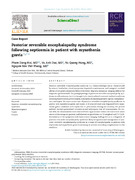Posterior reversible encephalopathy syndrome following septicemia in patient with myasthenia gravis

View/
Date
2023Author
Pham, Dang Hai
Vu, Anh Duc
Vu, Quang Hung
Nguyen, Van Viet Thang
Metadata
Show full item recordAbstract
Posterior reversible encephalopathy syndrome is a clinicoradiologic entity characterized by seizure, headaches, visual symptoms, impaired consciousness, and vasogenic cerebral edema of occipital and parietal lobes of the brain. Magnetic resonance imaging (MRI) is the diagnostic gold standard. The pathophysiology of posterior reversible encephalopathy syndrome is still unknown, but it is thought to be closely related to several medical conditions including hypertension, preeclampsia, eclampsia, immunosuppressive agents, transplantation, and sepsis. We report a rare case of posterior reversible encephalopathy syndrome in a patient with myasthenia gravis and sepsis. A 22-year-old male was diagnosed with myasthenia gravis combined with sepsis due to pneumonia. During his recovery, the patient suffered multiple generalized convulsions and subsequent loss of consciousness. On cranial MRI, the abnormalities were observed with hyperintense within the subcortical white matter of the temporal, parietal, and bilateral occipital lobes on T2-weighted and T2 FLAIR. Reversibility of the symptoms and characteristic imaging findings led us to a diagnosis of posterior reversible encephalopathy syndrome. Early recognition and management of posterior reversible encephalopathy syndrome as a cause of encephalopathy in patients with septicemia and myasthenia gravis is necessary to prevent secondary complications in this condition.
